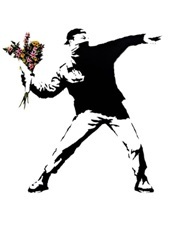
Written By:
Matthew Hiscox
Director of Trade Marks, Ince
Banksy, the renowned UK graffiti artist, has received a major blow in the EU in his attempt to maintain protection for his registered EU trade mark of his “Flower Thrower” work.
 Artists often rely on Copyright law, rather than trade marks, to protect their pieces of artwork. However, Banksy insists on maintaining his long standing anonymity and as such is unable to benefit from Copyright protection as in order to enforce his Copyright in his works (which exists as of right) he would have to reveal himself. Banksy, in his book “Wall and Piece”, stated that “Copyright is for losers”, promising to never commercially sell his works.
Artists often rely on Copyright law, rather than trade marks, to protect their pieces of artwork. However, Banksy insists on maintaining his long standing anonymity and as such is unable to benefit from Copyright protection as in order to enforce his Copyright in his works (which exists as of right) he would have to reveal himself. Banksy, in his book “Wall and Piece”, stated that “Copyright is for losers”, promising to never commercially sell his works.
Instead he has gone down the trade mark path, where the law around ownership differs slightly, and assists his anonymity efforts. He had pursued trade mark protection for a number of pieces of his artwork with a view to having the ability to protect and enforce against third parties wishing to use those pieces of artwork for commercial gain.
Background
In 2014 Pest Control Office Limited (the corporate front for Banksy) filed and registered the following trade mark entitled “the Flower Thrower” in a large number goods and services classes.
In 2019, Full Colour Black Limited, a UK greetings card company applied to invalidate the EU trade mark on the grounds that the trade mark was filed in bad faith under Article 59 (1)(b) of the EUTMR for all the goods and services covered by the trade mark registration. Full Colour Black uses Banksy’s artwork on greetings cards and Banksy considers this to be an infringement of his earlier rights. Full Colour Black argues that it simply sells cards featuring Banksy’s public graffiti, which is not an infringing act.
Full Colour Black asserted that Banksy had no intention to use the trade mark commercially, but still wished to benefit from the trade mark, which, it alleges, is an abuse of the trade mark system.
Readers may also remember that in 2019 Banksy set up a pop up store in Croydon, London. This was for the sole purpose of evidencing that there was commercial use of some of the goods and services protected under the trade mark. However, Banksy was also quoted saying “for the past few months, I’ve been making stuff for the sole purpose of fulfilling trade mark categories under EU law”. This appeared to be calculated, but it would have also been very difficult to evidence extensive use of the mark in the EU.
Decision
The EUIPO declared that the trade mark should be invalidated under Article 59 (1)(b) of the EUTMR on the basis that the mark was applied for in bad faith in respect of all of the goods and services under the trade mark.
It stated that the intention of Banksy was clearly to have exclusive legal rights over the work as he could not rely on Copyright protection, but that the function of a trade mark is not to offer an equivalent protection. In addition, it stated that Banksy clearly had no intent to use the mark, but only to circumvent the law, which it considered inconsistent with honest practices under the bad faith provision.
In addition, the EUIPO commented slightly further than expected in this case As it appears to assert that Banksy wishes to remain anonymous in order to conduct an illegal activity by painting graffiti on other people’s property without permission, instead of painting on canvasses or his own property. In relation to the issue of not obtaining permission (in turn making it an illegal activity), it stated that “no Copyright rights might accrue from such a work (or there is an argument that the Copyright may be assumed to be gifted to the owner of the property)”. This leads to further questions around ownership, and the ability to enforce or exploit rights, if artistic works are created in a similar way.
Conclusion
This is not the end of the road for Banksy as he has a number of trade marks and design registrations, owned via Pest Control Office Limited, but this adverse decision may pave the way for further challenges to Banksy’s registered IP.
The case clearly highlights the importance of using trade marks commercially in order to have the exclusive ability to protect, maintain, enforce and exploit your registered rights.
It also highlights the difficulties around disguising ownership and raises a number of questions around how IP ownership differs from each type of IP (Trade Marks, Copyright and Designs), so it is important to consider the different types of IP available to you.
Whilst quite rare in the art sphere, pseudonyms of book authors are more common. Even in the legal industry we have an anonymous book author named “The Secret Barrister”. Based on the outcome of this decision, it certainly brings into question the protection afforded to Copyright works and the ability to enforce and exploit those rights, where authors of such works wish to remain anonymous. This in turn may lead to additional considerations and reassurances in the relationship between publishers and authors in the future.
The information above is not and should not be taken to be legal advice. You should not take action or omit to take action based on this information.
If you require any help on the issues raised above please contact:
Matthew Hiscox, Director of Trade Marks
Tel: 029 2167 2684
Email: [email protected]






